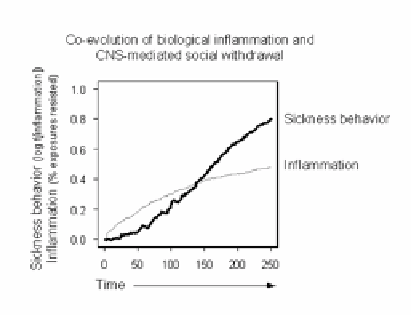Biomedical Engineering Reference
In-Depth Information
Figure 8
.
Evolution of disease-reactive social behavior
. In this evolutionary model, hosts reproduce
and pass a noisy copy of two individual characteristics to their offspring: (i) an inflammatory re-
sponse governing the probability of infection following exposure, and (ii) a sickness behavior pa-
rameter that drives probabilistic social withdrawal by the sick after infection. Inflammation is linearly
related to resistance (50% of exposures are resisted when inflammatory response = .5), and it is costly
in the sense that individual lifespan is shortened by its square (.5 inflammation induces a 25% reduc-
tion in average lifespan). The light line shows strong selective pressure for increased inflammatory
responses that begins to decelerate at ~40% resistance as its cost mounts. The sickness behavior
parameter (dark line) shows slow initial growth that begins to accelerate as inflammatory responses
become more pronounced (the log of the mean sickness gain parameter is plotted for comparison with
the linear inflammatory parameter). Once inflammatory responses begin to reach their cost-induced
limits, considerable selective advantage begins to accrue to those who reduce social behavior during
inflammatory reactions.
path (recall the stringent efficiency requirements for a successful quarantine in
Figure 4A). On the other hand, even weak individual protection can generate
strong herd immunity if it is widely distributed (4,14). The preeminent value of
consistency suggests that there should be strong selective pressure to develop
heritable genetic structures that reduce social contact during infection, even if
the individual impact is small. The evolving ActiveHost model of Figure 8
shows just this phenomenon in a model monitoring the emergence of disease-
reactive behavioral dynamics via neural reception of cytokine signals. In this
model, a population of 100 individuals, each randomly linked to 5 others, is at-
tacked by a fatal infection that is transmissible for 2 time units prior to the ap-
pearance of illness signs and 18 time units subsequently. The host population
begins with a inflammatory response of 0 (all exposures result in infection), and
parents pass on to their progeny their own resistance level modified by a small
noise factor. Inflammation is linearly related to resistance (50% of exposures are
resisted when inflammatory response = .5) and inflammation is costly in the


